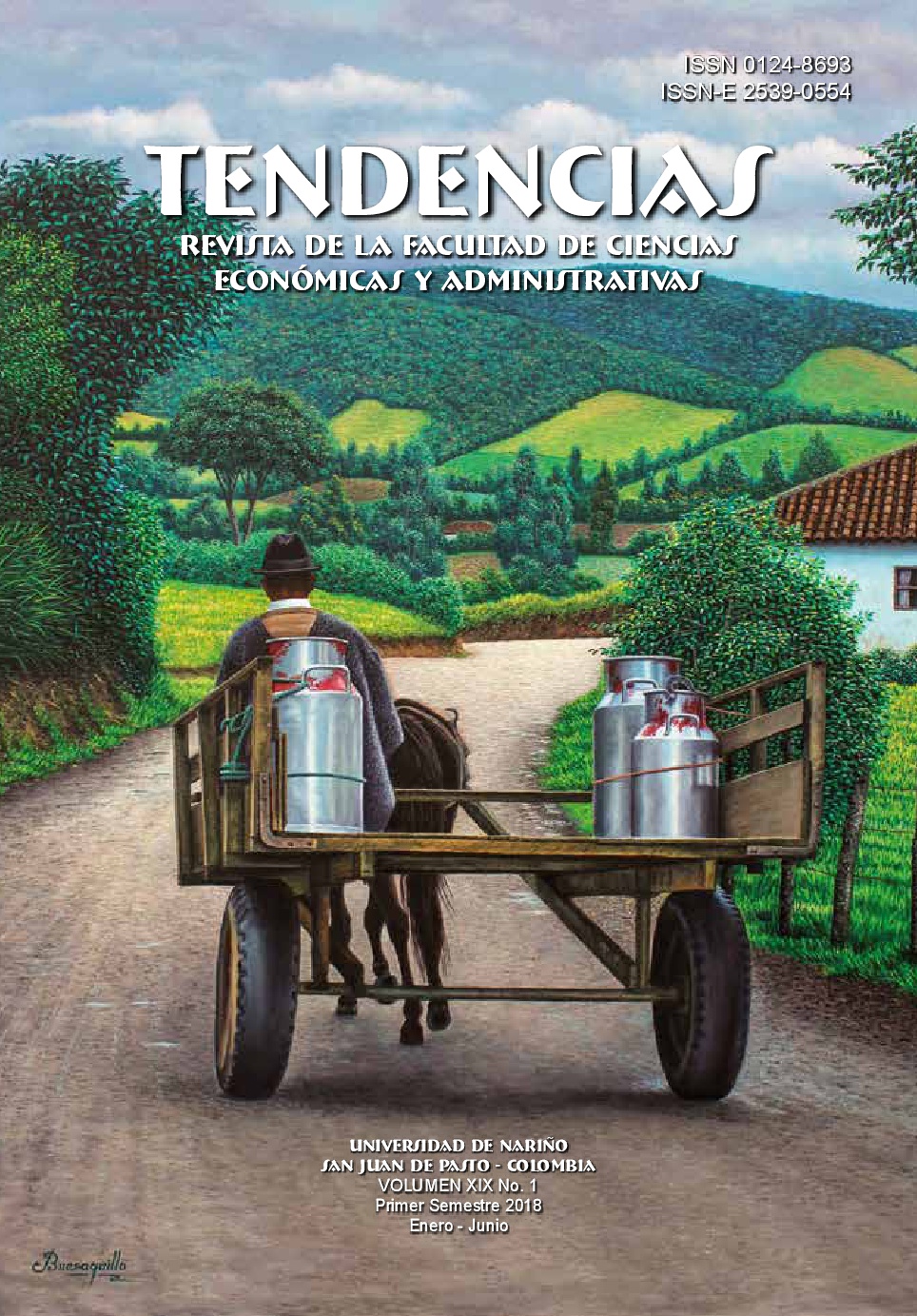Isomorfism of telecommunications services: a quantitative analysis
DOI:
https://doi.org/10.22267/rtend.181901.88Keywords:
Isomorphism, Mimetic isomorphism, Telecommunications services, Informal institutions, CultureAbstract
The mimetic isomorphism proposed by DiMaggio & Powell (1983) occurs in organizational fields where the rational effort of each company to reduce the uncertainty and produces homogeneity between organizations; which the literature would be supposed to happen in the telecommunications sector on worldwide. This article demonstrates the hypothesis and uses an unbalanced data panel model to determine the differences in the provision of telecommunications services for 69 countries. This study was made for the years 2010-2015. The findings show the differences in the provision of services between countries by technology and the incidence of informal institutions. We concluded there is no isomorphism at the level of the countries studied.
Downloads
References
(1) Álvarez, C; Urbano, D. (2012). “Cultural-cognitive dimension and entrepreneurial activity: a cross-country study”. En: Revista de Estudios Sociales, Vol.44, pp. 146-157.
(2) Álvarez, C; Urbano, D. (2013). “Diversidad cultural y emprendimiento”. En: Revista de Ciencias Sociales, Vol. 19, Núm. 1, Marzo, pp. 154-169.
(3) Álvarez, C; Urbano, D; Corduras, A; Ruíz-Navarro, J (2011). “Environmental conditions and entrepreneurial activity: a regional comparison in Spain”. En: Journal of Small Business and Enterprise Development, Vol. 18, Núm. 1, pp. 120-140.
(4) Baltagi, B; Wu, P (1999). “Unequally spaced data regressions with AR(1) disturbances”. En: Econometric Theory, Vol. 15, Núm. 6, pp. 814-823.
(5) Camargo, D; Cardona, O; Roncancio, A. (2017). Un Análisis de los servicios de telecomunicaciones, 2010-2015. En: Sinapsis, Vol. 9, Núm. 1, pp. 12- 28.
(6) Coller, X; Edwards, T; Rees, C (1999). Difusión e isomorfismo en las organizaciones multinacionales. En: REÍS, Núm. 86, pp. 79-94.
(7) Dimaggio, P; Powell, W (1983). “The iron cage revisited: Institutional isomorphism and collective rationality in organizational fields”. En: American Sociological Review, Vol. 48, Núm. 2, pp. 147-160.
(8) Fenell, M (1980). “The effects of environmental characteristics on the structure of hospital cluster”. En: Administrative Science Quarterly, Vol. 25, Núm. 3, pp. 485-510.
(9) Ganga, F; Pedraja-Rejas, L; Quiroz, J; Rodríguez-Ponce, E. (2017). Breves aproximaciones teóricas y algunas aplicaciones a la educación superior. En: Revista Espacios, Vol. 38, Núm. 20, pp. 31-43.
(10) GEM (2017). Global report 2016 / 2017. Disponible en: http://www.gemconsortium.org/report/49812
(11) Guajarati, D; Porter, D. (2009). Econometría (5 ed.). México D.F.: McGraw-Hill.
(12) Hannan, M; Freeman, J. (1977). The population ecology of organizations. En: American journal of sociology, Vol. 82, Núm. 5, pp. 929-964.
(13) Labra, R; Torrecillas, C. (2016). “Guía CERO para datos de panel. Un enfoque práctico”. Cátedra UAM-Accenture en Economía y Gestión de la Innovación. [En línea] Disponible en: https://www.uam.es/docencia/degin/catedra/documentos/16_Guia%20CERO%20para%20datos%20de%20panel_Un%20enfoque%20practico.pdf
(14) Lagos, D; Betancourt, J; Gómez-Betancourt, G. (2017) “Implementación de prácticas de gobierno corporativo en Colombia: un análisis desde el isomorfismo institucional en empresas familiares y no familiares”. En: Revista de la Facultad de Ciencias Económica: Investigación y Reflexión. rev.fac.cienc.econ, Vol. XXV, Núm. 2, pp. 139 - 157.
(15) Meyer, J. (1979). “The impact of the centralization of educational funding and control on state and local organizational governance”. Stanford, CA: Institute for Research on Educational Finance and Governance, Stanford University, Report No. IFG-PR-79-B20. [En línea] Disponible en: https://files.eric.ed.gov/fulltext/ED202139.pdf
(16) Miguel-Dávila, J; López, D; De Pablos-Heredero, C. (2012). “El sector de la telefonía móvil como modelo de negocio abierto en un contexto de innovación sistémica”. En: Universia Business Review, Núm. 36, pp. 48-62.
(17) Nieto, M (2009). “Análisis de los efectos del Capital Social sobre el proceso de Creación Empresarial”. En: Hernández, R; Fuentes, M; Rodríguez, L. (coords.) Creación de empresas: aproximación al estado del arte (pp. 295-312). Lisboa: Juruá.
(18) North, D. (1993). Instituciones, cambio institucional y desempeño económico. México: Fondo de Cultura Económica.
(19) Pinillos, M; Reyes, L. (2011). “Relationship between individualist–collectivist ulture and entrepreneurial activity: evidence from Global Entrepreneurship Monitor data”. En: Small Business Economics, Vol. 37, Núm. 1, pp. 23-37.
(20) Powell, W; Dimaggio, P. (1991). “Retorno a la jaula de hierro: el isomorfismo institucional y la racionalidad colectiva en los campos organizacionales”. En: Powell, W; Dimaggio, P. (Eds.) El nuevo institucionalismo en el análisis organizacional. México: Fondo de Cultura Económica.
(21) Ramírez, M.. (2013). “Instituciones informales y actividad emprendedora. Una aproximación metodológica desde D. North”. En: Revista Ciencias Estratégicas, Vol. 21, núm. 9, pp. 15-30.
(22) Rodríguez, B (2007). “Modos de racionalidad, discurso organizativo y presiones institucionales un estudio del sector de la telefonía móvil en España”. Tesis doctoral. Universidad Autónoma de Madrid. [En línea] Disponible en: https://repositorio.uam.es/bitstream/handle/10486/2504/2388_merino_rodriguez_belen.pdf?sequence=1&isAllowed=y
(23) Rubalcaba, L. (2008). Los servicios en la economía Europea: desafíos e implicaciones de política económica. Barcelona: Fundación Rafael del Pino.
(24) Sud, M; Vansandt, C; Baugous, A. (2009). “Social entrepreneurship: the role of institutions”. En: Journal of business ethics, Vol. 85, Núm. 1, pp. 201-216.
Published
How to Cite
Issue
Section
License
Those authors who have publications with this journal, accept the following terms:
This journal is licensed under a Creative Commons Reconocimiento-NoComercial 4.0 Internacional License. The articles can be copied, distributed, adapted and communicated publicly, as long as the credits of the work are recognized and the respective source is quoted. This work can not be used for commercial purposes.
To increase their visibility, documents are sent to databases and indexing systems.
The content of the items is the responsibility of each author, and does not compromise in any way, journal or institution.







































